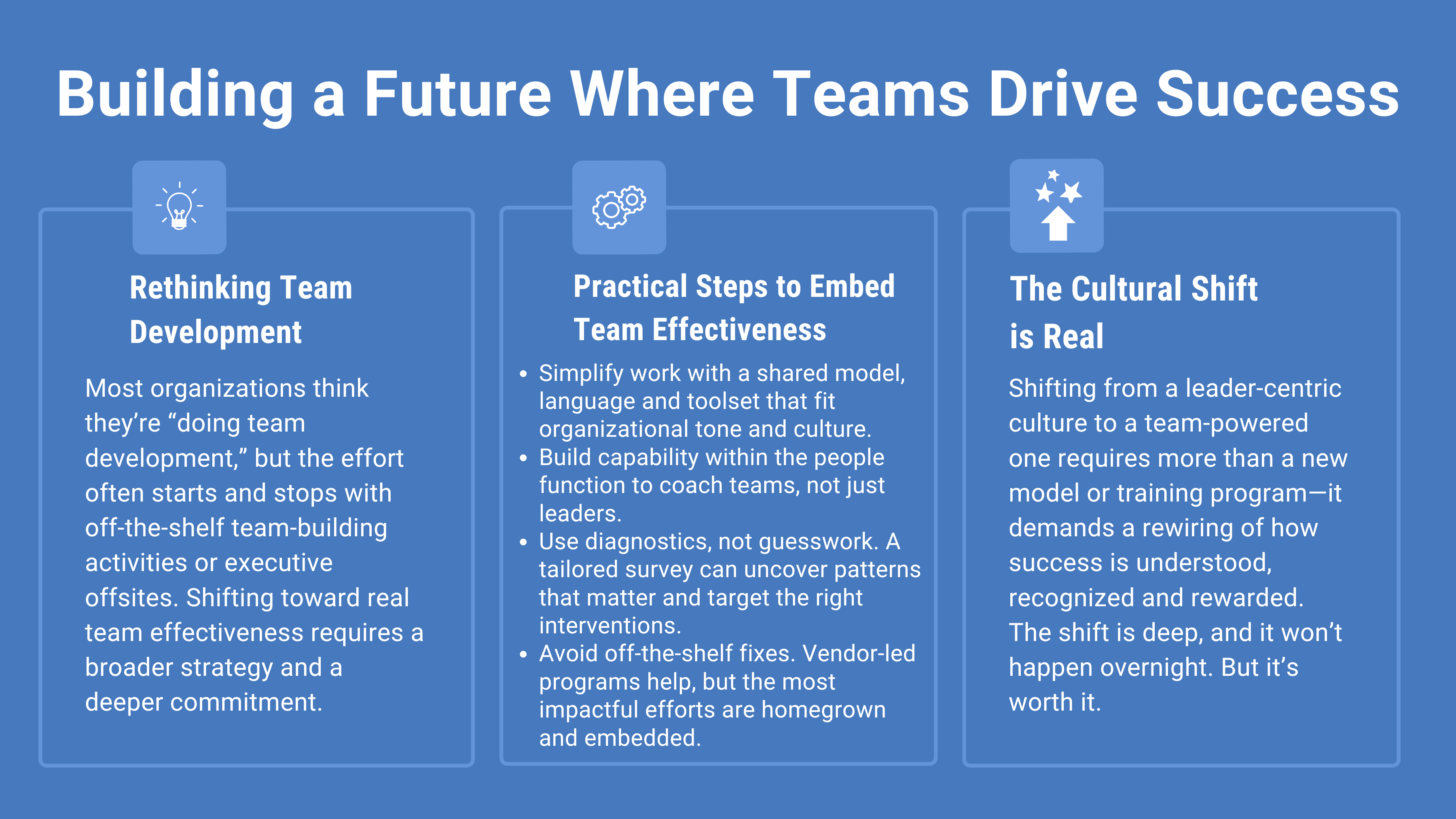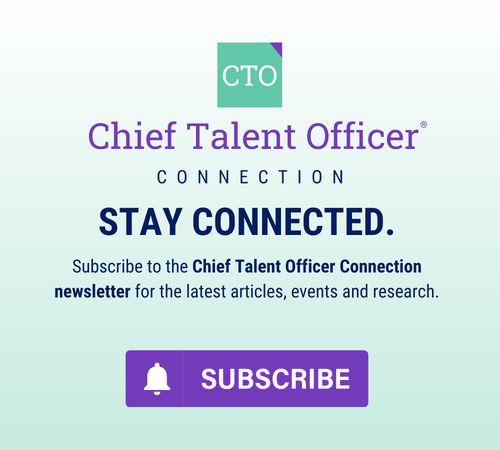“An incredibly strong leadership pipeline is the key to organizational success.” Right?
That’s the thinking behind the decades-long dominance of leadership development in our approach to talent management. And in most cases the focus on leadership forms the bedrock of a flourishing culture of achievement, commitment, and grit. But are there any downsides? A review of the current talent landscape suggests there are. And focusing on teams might be the antidote to restore balance.
Here are five hidden costs of cultures that overemphasize leadership (Do any of these resonate with your organization?):
- The HiPo bias: Attuned to the value of high-potential leaders, the organization devotes attention and resources to accelerating its success. As a result, strong team contributors tend to get overlooked if they’re not designated as high-potential or the organization doesn’t see future opportunities for their advancement.
- The silo effect: A leadership-first culture signals that career growth happens through vertical progression. As a result, cross-functional collaboration remains elusive—even at the c-suite level where leaders who’ve spent their careers in silos suddenly need to operate as one team.
- The recognition gap: Success is often attributed to leaders because the culture sees challenges as opportunities for capable leadership. Team members, even though they might have done most of the work, feel unseen, leading to disengagement.
- The individual reward trap: Most reward systems are designed around individual achievement, reinforcing a culture of solo performance over collective success. Compensation and bonuses often emphasize personal metrics, with little connection to team-based outcomes like shared goals or collective performance.
- The leadership gamble: When organizations over-invest in a few key leaders, they become vulnerable if those individuals leave or underperform. The result is a scramble to recover, often by doubling down on succession planning and bench strength—efforts that only reinforce an individual-centered talent strategy.
Given the risks involved, what can an organization do to balance a decades-long focus on individual leader achievement? Developing team effectiveness is a wonderful way to balance the scales and even enhance the impact of leadership development. Research has underscored the value of developing teams for years, yet most organizations still equate team effectiveness with more superficial team-building activities. This confusion has left a massive gap in talent strategies—and a missed opportunity to unlock the full potential of the workforce.
How team effectiveness creates balance
Let’s start by addressing a common misconception: Team effectiveness is not the same as team building.
Team building often refers to short-term activities designed to foster interpersonal relationships and build trust. These might include offsite retreats, icebreaker games or collaborative challenges designed to help team members get to know each other. While these experiences are often engaging (and yes, fun), they usually focus on integration rather than execution.
Team effectiveness, by contrast, is the sustained and intentional development of a team’s ability to achieve its objectives together. It includes the ability to navigate conflict, clarify roles and goals, establish strong norms and continuously assess progress. It’s not about helping people get along—it’s about helping them get things done.
Team building can support team effectiveness, especially in the early stages of team formation, but team effectiveness is real work. It’s about surfacing friction, aligning on processes, refining ways of working and improving performance over time. And while it might not always feel like a game or a trust fall, many teams find the work of improving together incredibly satisfying—especially when it’s tied to shared purpose and results.
The strategic value of team effectiveness
When organizations invest in developing effective teams, they’re not just strengthening execution—they’re building resilience into the system.
Strong teams create a kind of organizational glue. As individuals come and go, or step into new roles, the team continues to function. High-performing teams are not dependent on a single person at the helm—they can onboard a new leader and maintain momentum, creating a more sustainable rhythm of work.
This is particularly important when HiPo leaders are given big opportunities. Rather than betting everything on a leader’s ability to rally the group and hit the ground running, a well-developed team can carry the operational load, allowing the leader to focus on strategy, innovation and culture-shaping. In this way, team effectiveness not only supports business continuity—it also amplifies the impact of leadership development.
Moreover, teams that operate with effectiveness tend to model behaviors that ripple outward: accountability, transparency, cross-functional collaboration and continuous learning. These are cultural accelerants—and when embedded across the organization, they reduce dependency on individual heroics and shift the narrative from “who’s in charge?” to “how are we working together?”
Case study: PepsiCo’s SUPER5 team effectiveness program
The SUPER5 model was developed as a direct response to a common problem in large, matrixed organizations: Everyone was working on team effectiveness, but no one was speaking the same language.
Across regions, teams were tackling similar challenges with different models, terminology and practices. When individuals moved geographies or collaborated cross-functionally, team cohesion and speed to impact suffered. SUPER5 was designed to change that.
It wasn’t meant to revolutionize how teams function—it was meant to standardize and simplify. Team effectiveness isn’t new, and it certainly isn’t rocket science. The way we talk about it shouldn’t be either. SUPER5 offered a clean slate: a simple, shared framework that any team—anywhere in the organization—could understand and apply.
The 5 dimensions of SUPER5
Each SUPER5 dimension represents a core element of team effectiveness. Together, they help teams align, collaborate and execute:
- Set a shared direction and strategy: Teams clarify their purpose, long-term direction and immediate goals. They agree on what success looks like—and how they’ll know they’re making progress.
- Understand unique skills and styles: Teams surface individual strengths and preferences, so they can optimize collaboration and distribute responsibilities effectively.
- Perfect the process: Teams assess and refine how they work—roles, norms, decision-making, communication—so they can deliver with less friction.
- Engage and energize: Teams focus on building trust, motivation and inclusion, so members feel connected, valued, and committed.
- Re-evaluate and reinforce for results: Teams reflect on what’s working and what’s not. They adjust quickly, celebrate wins and hold each other accountable for learning and improvement.
The beauty of SUPER5 lies in its versatility—the dimensions and tools are agnostic to level. Whether it’s a c-suite leadership team or a frontline operational crew, the model holds up with minimal tweaking required.
Results that speak for themselves
SUPER5 launched in 2023, and in just two years, the program has scaled faster than anyone anticipated. It’s been adopted globally across sectors, functions and levels. Along the way, it has earned PepsiCo’s Chairman’s Award—the company’s highest internal honor—and a Gold Brandon Hall Award for Best Team Development Program.
What we created:
- A shared framework used across regions and levels.
- A diagnostic tool to assess team strengths and gaps.
- A suite of tools and facilitation guides.
- Certification programs to scale capability in-house.
What we’ve seen:
- Over 500 teams (nearly 6,000 employees) have completed the SUPER5 diagnostic.
- More than 3,000 leaders are actively using the framework with their teams.
- 350-plus HR professionals certified as team coaches.
- 1,500-plus team members trained as SUPER Team Players.
Perhaps most impressive: The model, which first gained traction with executive teams—often a difficult group to reach with anything resembling “team building”—has proven nimble enough to scale across all levels of the organization. Its simplicity allows it to be flexibly deployed based on team maturity, business need or rollout strategy. Whether used with senior leadership teams navigating strategic alignment or frontline teams refining day-to-day processes, the model holds up.
That same flexibility has made SUPER5 a natural home for our Inclusion work, offering a way to engage teams in inclusion through the lens of how they work together. By integrating Inclusion tools and language under the SUPER5 umbrella, we’ve been able to advance this critical work in a way that feels organic and action-oriented, rather than separate or supplemental.

A call to action for talent leaders
Leadership development still matters. But team effectiveness may be the most underleveraged lever in talent management today.
If we want cultures where collaboration thrives, innovation accelerates and performance is sustained over time—we need to invest in teams.
So here’s the challenge for every L&D and talent management professional: Is your organization truly investing in teams?
















